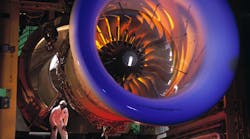"More for less" -- no manufacturer competing today is above this universal and contradictory call. It is the battle cry of 21st-century manufacturing -- a relentless, unnegotiable demand for more goods at higher quality than ever before, produced at costs far lower than previously imaginable.
In a very practical sense, obeying that "more for less" edict has become a basic requirement for any level of production in just about any industry today.
It is not, however, evenly applied.
For companies like Pratt & Whitney, the market, mixed with an austere spending environment, has exaggerated that demand far beyond that of most other manufacturers.
"Pratt & Whitney is known around the world for quality and dependable engines," said Danny Di Perna, vice president of Module Centers & Operations at Pratt & Whitney. "So it is absolutely fundamental for us to maintain our dependable engine logo."
At the same time, he explained, in this era of austerity and sequestration, the United Technologies Corp. (IW 500/24) aircraft engine maker has been under tremendous pressure from the U.S. government -- one of its biggest clients -- to significantly reduce costs in order to maintain its contracts.
This has put the company in a serious bind: engines like its acclaimed F135, which it produces for the Lockheed Martin (IW 500/30) F-35 jet, by necessity require expensive, precise processes in which there is no room for fault. But to keep its place in the project, the company had to shave millions off the cost of that process.
The solution to that puzzle, Di Perna explained, was to double down on its engineering investments and use that capital to find and develop new techniques to transform its production system into the lean, streamlined system it needed.
In other words, Pratt & Whitney had to innovate.
Pratt & Whitney's High-Tech Innovations
"What we're doing here at Pratt & Whitney with our investments is all about how we can invest more development technology to improve the process repeatability, process capability and overall quality of the components that go into our engines," Di Perna said.
To do so, he explained, the company has defined a tight work process around new technologies to help it innovate and experiment with new technologies and new tools like 3-D engineering and rapid prototyping.
In the aerospace industry, however, such experiments are not taken lightly.
"Our goal is to get first time quality right out of the gate," Di Perna said. "To get there, we put technology at the forefront of our investments, but first we put new technologies through a technology maturation process so we can develop them and get them ready for prime time."
"The idea is to take what is just in the universities, what is proven as a concept and bring it in, try to prove it and apply it to our type of components," explained Donald McIntosh, senior fellow of Manufacturing Technology at Pratt & Whitney Canada.
As the company introduces new products or looks for way to improve the legacy products like the F135, he said, those technologies that pass muster in their technology incubators quickly become critical to the manufacturing process.
"The way we start out is with the concept of intelligent manufacturing," he explained. "Intelligence is about knowing, it’s about understanding, it's about an ability to adapt and react to things."
Employing new emerging technologies, he said, is the only way to increase that level of understanding and keep driving continuous improvement.
The effects of that process are echoing through the Pratt & Whitney plants across the world.
"You can see how it has changed the shop floor for our operators," noted Mike Pcholinski, vice president of Development Operations at Pratt & Whitney.
"You go back a while and we had gauges and our coordinate measuring machines," he said. "Now we're more into 3-D scanning system, which gives us a lot more information about parts, about the quality of parts, the signature of parts, where they're targeted very quickly."
Simply, he added, "we have more options these days and we can carry those options quicker and better on a global scale."
Taking Innovation to the Supply Chain
To make the kinds of cuts required by Lockheed Martin and the U.S. military, though, Pratt & Whitney had to look further than its own operations. Real cost-saving, more-for-less innovation required digging into its supplier network, where as much as 80% of the work on the F135 is done.
"Our position in the market with the F135 engine has given us the ability to ramp up our supply chain and work with more and more suppliers around the world as we develop capability and capacity," Di Perna explained.
"We're looking for suppliers that can make the investments, that can develop alongside of us," he added. "We want them to be deploying these techniques, these new manufacturing technologies, to improve quality of parts that they supply for us so we can continue to manufacturer dependable engines."
With that power and that drive behind them, Pratt & Whitney seems to be fulfilling its more-for-less mission. By the latest account, the cost of the F135 engine has dropped some 40% since the delivery of its first production engine.





